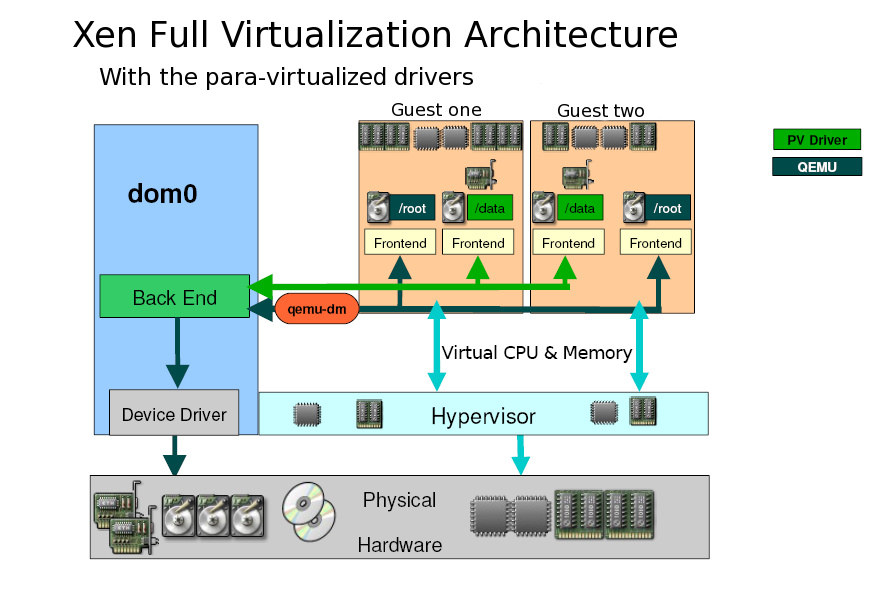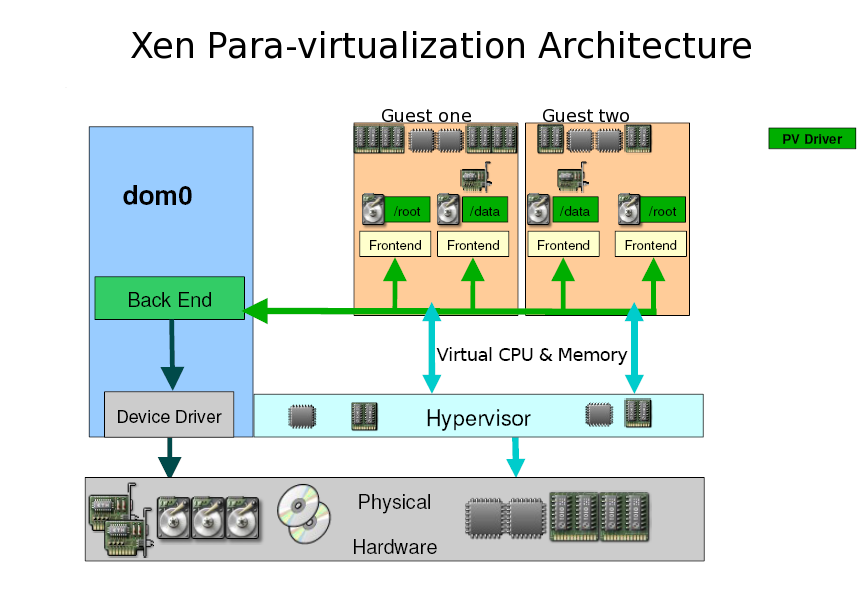This glossary is intended to define the terms used in this Installation Guide.
- Bare-metal
The term bare-metal refers to the underlying physical architecture of a computer. Running an operating system on bare-metal is another way of referring to running an unmodified version of the operating system on the physical hardware. Examples of operating systems running on bare metal are
dom0 or a normally installed operating system.
- dom0
Also known as the
Host or host operating system.
dom0 refers to the host instance of Linux running the
Hypervisor which facilitates virtualization of guest operating systems. Dom0 runs on and manages the physical hardware and resource allocation for itself and the guest operating systems.
- Domains
domU and
Domains are both domains. Domains run on the
Hypervisor. The term domains has a similar meaning to
Virtual machines and the two are technically interchangeable. A domain is a Virtual Machine.
- domU
domU refers to the guest operating system which run on the host system (
Domains).
- Full virtualization
Xen and KVM can use full virtualization. Full virtualization uses hardware features of the processor to provide total abstraction of the underlying physical system (
Bare-metal) and create a new virtual system in which the guest operating systems can run. No modifications are needed in the guest operating system. The guest operating system and any applications on the guest are not aware of the virtualized environment and run normally. Para-virtualization requires a modified version of the Linux operating system.
- Fully virtualized
- Guest system
Also known as guests, virtual machines or
domU.
- Hardware Virtual Machine
- Hypervisor
The hypervisor is the software layer that abstracts the hardware from the operating system permitting multiple operating systems to run on the same hardware. The hypervisor runs on a host operating system allowing other virtualized operating systems to run on the host's hardware.
- Host
The host operating system, also known as
dom0.
- I/O
Short for input/output (pronounced "eye-oh"). The term I/O describes any program, operation or device that transfers data to or from a computer and to or from a peripheral device. Every transfer is an output from one device and an input into another. Devices such as keyboards and mouses are input-only devices while devices such as printers are output-only. A writable CD-ROM is both an input and an output device.
- Kernel-based Virtual Machine
KVM (Kernel-based Virtual Machine) is a
Full virtualization solution for Linux on AMD64 and Intel 64 hardware. VM is a Linux kernel module built for the standard Linux kernel. KVM can run multiple, unmodified virtualized guest Windows and Linux operating systems. KVM is a hypervisor which uses the libvirt virtualization tools (virt-manager and virsh).
KVM is a set of Linux kernel modules which manage devices, memory and management APIs for the Hypervisor module itself. Virtualized guests are run as Linux processes and threads which are controlled by these modules.
- LUN
A Logical Unit Number (LUN) is a number assigned to a logical unit (a SCSI protocol entity).
- Migration
Migration is name for the process of moving a virtualized guest from one host to another. Migration can be conducted offline (where the guest is suspended and then moved) or live (where a guest is moved without suspending). Xen fully virtualized guests, Xen para-virtualized guest and KVM fully virtualized guests can all be migrated.
Migration is a key feature of virtualization as software is completely separated from hardware. Migration is useful for:
Load balancing - guests can be moved to hosts with lower usage when a host becomes overloaded.
Hardware failover - when hardware devices on the host start to fail, guests can be safely relocated so the host can be powered down and repaired.
Energy saving - guests can be redistributed to other hosts and host systems powered off to save energy and cut costs in low usage periods.
Geographic migration - guests can be moved to another location for lower latency or in serious circumstances.
Shared, networked storage is used for storing guest images. Without shared storage migration is not possible.
An offline migration suspends the guest then moves an image of the guests memory to the destination host. The guest is resumed on the destination host and the memory the guest used on the source host is freed.
The time an offline migration takes depends network bandwidth and latency. A guest with 2GB of memory should take several seconds on a 1 Gbit Ethernet link.
A live migration keeps the guest running on the source host and begins moving the memory without stopping the guest. All modified memory pages are tracked and sent to the destination after the image is sent. The memory is updated with the changed pages. The process continues until it reaches some heuristic; either it successfully copied all the pages over, or the source is changing too fast and the destination host cannot make progress. If the heuristic is met the guest is briefly paused on the source host and the registers and buffers are sent. The registers are loaded on the new host and the guest is then resumed on the destination host. If the guest cannot be merged (which happens when guests are under extreme loads) the guest is paused and then an offline migration is started instead.
The time an offline migration takes depends network bandwidth and latency as well as activity on the guest. If the guest is using significant I/O or CPU the migration will take much longer.
- MAC Addresses
The Media Access Control Address is the hardware address for a Network Interface Controller. In the context of virtualization MAC addresses must be generated for virtual network interfaces with each MAC on your local domain being unique.
- Para-virtualization
Para-virtualization uses a special kernel, sometimes referred to as the Xen kernel or the kernel-xen package. Para-virtualized guest kernels are run concurrently on the host while using the host's libraries and devices. A para-virtualized installation can have complete access to all devices on the system which can be limited with security settings (SELinux and file controls). Para-virtualization is faster than full virtualization. Para-virtualization can effectively be used for load balancing, provisioning, security and consolidation advantages.
As of Fedora 9 a special kernel will no longer be needed. Once this patch is accepted into the main Linux tree all Linux kernels after that version will have para-virtualization enabled or available.
- Para-virtualized
- Para-virtualized drivers
Para-virtualized drivers are device drivers that operate on fully virtualized Linux guests. These drivers greatly increase performance of network and block device I/O for fully virtualized guests.
- Security Enhanced Linux
Short for Security Enhanced Linux, SELinux uses Linux Security Modules (LSM) in the Linux kernel to provide a range of minimum privilege required security policies.
- Universally Unique Identifier
A Universally Unique Identifier (UUID) is a standardized numbering method for devices, systems and certain software objects in distributed computing environments. Types of UUIDs in virtualization include: ext2 and ext3 file system identifiers, RAID device identifiers, iSCSI and LUN device identifiers, MAC addresses and virtual machine identifiers.
- Virtualization
Virtualization is a board computing term for running software, usually operating systems, concurrently and isolated from other programs on one system. Most existing implementations of virtualization use a hypervisor, a software layer on top of an operating system, to abstract hardware. The hypervisor allows multiple operating systems to run on the same physical system by giving the guest operating system virtualized hardware. There are various methods for virtualizing operating systems:
- Virtualized CPU
A system has a number of virtual CPUs (VCPUs) relative to the number of physical processor cores. The number of virtual CPUs is finite and represents the total number of virtual CPUs that can be assigned to guest virtual machines.
- Virtual machines
A virtual machine is a software implementation of a physical machine or programming language (for example the Java Runtime Environment or LISP). Virtual machines in the context of virtualization are operating systems running on virtualized hardware.
- Xen
Fedora supports the Xen hypervisor and the KVM hypervisor (refer to
Kernel-based Virtual Machine). Both hypervisors have different architectures and development approaches. The Xen hypervisor runs underneath a Linux operating system which acts as a host managing system resources and virtualization APIs. The host is sometimes referred to as as
dom0 or Domain0.



